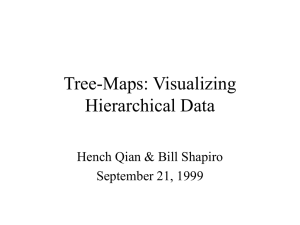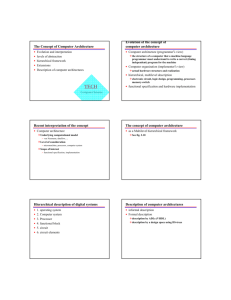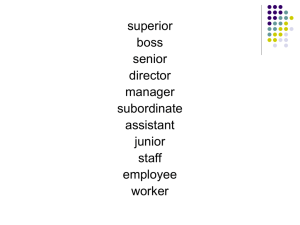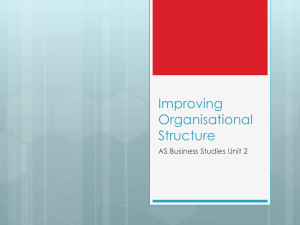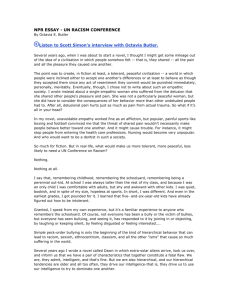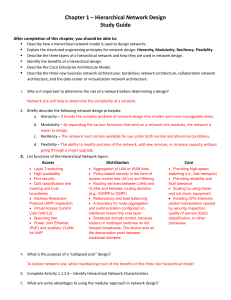Company Structures: Hierarchical, Flat, & Flexible Models
advertisement
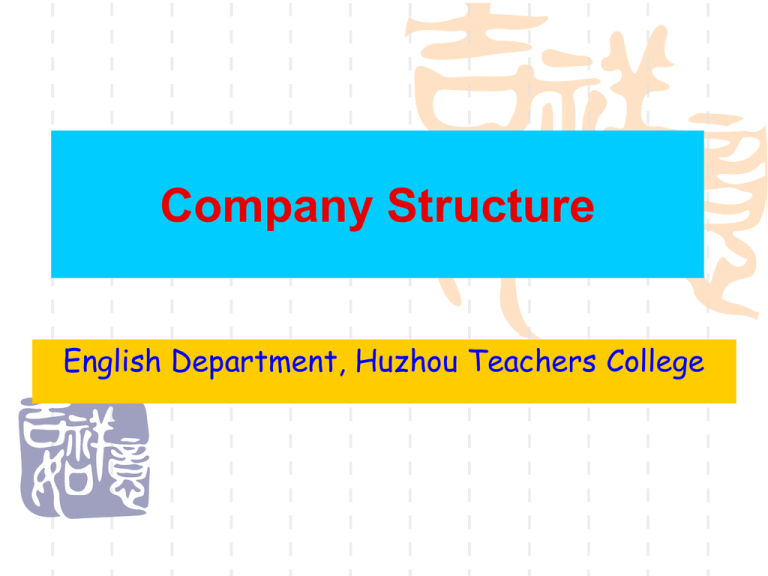
Company Structure English Department, Huzhou Teachers College Objectives 1 ) To enable students to talk about company structure. 2) To know three major kinds of company structures, their corresponding advantages and disadvantages. 3) To practise reading for specific information. 4) To review the past simple, present perfect simple and present perfect continuous. Tasks and schemes 1) Check 8’ 2) Reading two 37’ Reading on page 10: 1. Three kinds of company structures(see the diagram on page 9): 1) Hierarchical pyramid structure: =Hierarchical management structure A Large established company 层级制金字塔管理结构,即层级制组织 结构,是公司组织结构形式之一。这种 结构的特点是,公司内部功能齐全,科 室设置完备,公司组织层次多,机构呈 纵向垂直构架。自上而下逐级授权,自 下而上逐级汇报,信息流通缓慢,沟通 渠道有限,多重领导,效率底下。 2) Flat management structure: 扁平化的管理结构。公司组织结构形式之一。 公司经理即公司所有人,这类企业通常是小型 公司。组织结构简单机构呈横向扁平设立,信 息反馈环节少,效率高,管理层对经营环节既 不失去控制,又能使企业反应快速。及时反馈 信息保证了有效管理和竞争优势。它与 Hierarchical pyramid structure相对。 3) Flexible company with project-based teams: 由项目小组组成的灵活公司体系。由基本信息 技术、自我管理、分工明确的任务小组或者事 业单位构成,公司组织结构呈现灵活机动的特 性,该组织结构按项目小组设立,各项目小组 或事业单位直接对分管总经理负责。既能有效 管理庞大复杂的层级制组织结构,又可以保持 企业家式新兴公司的快速反应。信息技术作为 该组织结构协调管理和决策反馈的中枢。 2. Difficult points: 1) • Big small company 标题中采用的是oxymoron(矛盾修饰法)。 Oxymoron: A rhetorical figure in which incongruous or contradictory terms are combined, as in a deafening silence and a mournful optimist. 矛盾修饰法:是将两个互相矛盾,互不调和的词放在 同一个短语中,产生特殊的深刻含义的一种修辞手段。 如:震耳欲聋的沉默 和 悲伤的乐观 翻译和理解这种短语时,不宜只看字面意义,应根据 上下文,试图从相互矛盾的形象概念中找到其内在的 语义联系,译出经过凝缩的意义。本文标题的实际内 涵是融合了知名大企业和新创办的小公司各自优点长 处的公司体制。 根据课文内容,可以翻译为:“健全高小的公司体 制”、“规模健全而又反应快速的公司”、“大而精 干的公司”、“反应快速的大公司”等。 2) With speed increasingly seen as the key to competitive advantage, the dream is to marry the control of an established company with the responsiveness of a start-up. • Start-up原指开始、启动,现在被赋予了新的涵义, 指“新创立的小公司”、“新兴公司”,尤其指那 些网络公司(dot-com companies)。 如今,速度越来越被认为是获得竞争优势的关键。 人们向往着能将知名老牌企业的管理能力和新兴公 司的快速反映能力结合起来。 3) Feasible: possible; able to be carried out or done. 4) More nimble (agile; quick, light, and neat in movement.)rivals: 5) Any sizeable organization • 具有一定规模的公司 特别注意: 在商务语境中,organization 通常指大型企业 或公司。(i.e. organization chart: a diagram showing all the departments in a company and the people who work in them, with the most powerful people at the top.) 6) the control inherent(forming a natural part of a set of qualities, a character, etc. ) in a hierarchical structure. 7) These jobs are separated into sequential steps. Sequential: in regular succession without gaps (顺序的 ) 8) Operating process经营环节,经营过程 9) Management process管理环节,管理过程 10) Entrepreneurial organization 企业家组织结构,企业家体制(指经 理人为公司所有者、经营管理均由其 个人组织协调、不受雇于他人的小公 司。此类公司机构单一,不存在多层 级管理,也称扁平化组织结构) 11) information age structure信息时代的 组织结构 12) Line workers: the workers under line management. Line management: (直线业务及人事 管理)它是大型机构的一种管理体系, 分别有业务经理和行政经理,前者负 责经营、销售等主要环节,后者负责 后勤业务。 13) A dynamic information-enabled learning process. 以信息为手段的动态学习过程。 Corresponding exercises on the reading comprehension. 1) What are the advantages and disadvantages of each company structure in the text? Hierarchical organization • advantages High level of control • disadvantages Workers lack the authority and motivation to improve processes. Management’s response time is slow. Only suitable for stable business environments Entrepreneurial organization • advantages Totally centralized authority and direct contact between owner and employees ensure responsiveness to external changes. • disadvantages Only suitable for small companies Information age organization • advantages Allows speed of response within a large complex structure. Retains control but gives quick access to information. Employees can constantly refine their actions and strategies. Organizational control is dynamic. • disadvantages Although IT makes all these advantages possible, it cannot motivate people to use the information they have. What is the difference between operating and management processes? Operating processes are concerned with how a company produces and sells its products and services. Management processes are concerned with how a company directs and controls these operations. 2) 3) How do hierarchical companies ensure control of operating systems? Jobs are standardized and separated into sequential steps which are carried out under direct supervision. 4) How can entrepreneurial companies be responsive and retain control? There is daily personal interaction between the owner and employees. 5) Why does information alone not guarantee effective management? Access to information alone cannot motivate people to use that information on behalf of the organization. Organizations need to ensure that the information is used by managers and employees to accomplish the same goals.

